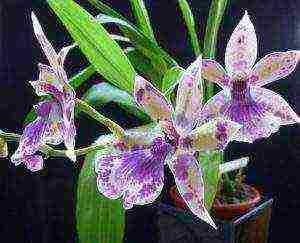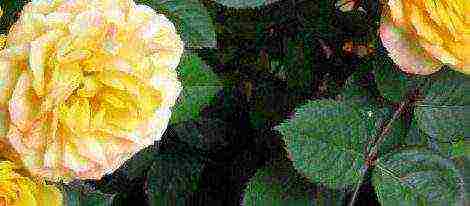Content
Citrus fruits are the first exotic plants to be grown outside the botanical homeland. Homemade lime is a close relative of lemon, which is grown from a stone in a closed ground.
Description
In natural growing conditions, the lime tree reaches 5 m in height. Depending on the variety, it can be a tree with a dense branching crown or a shrub, the trunk and branches of which are covered with thorns.
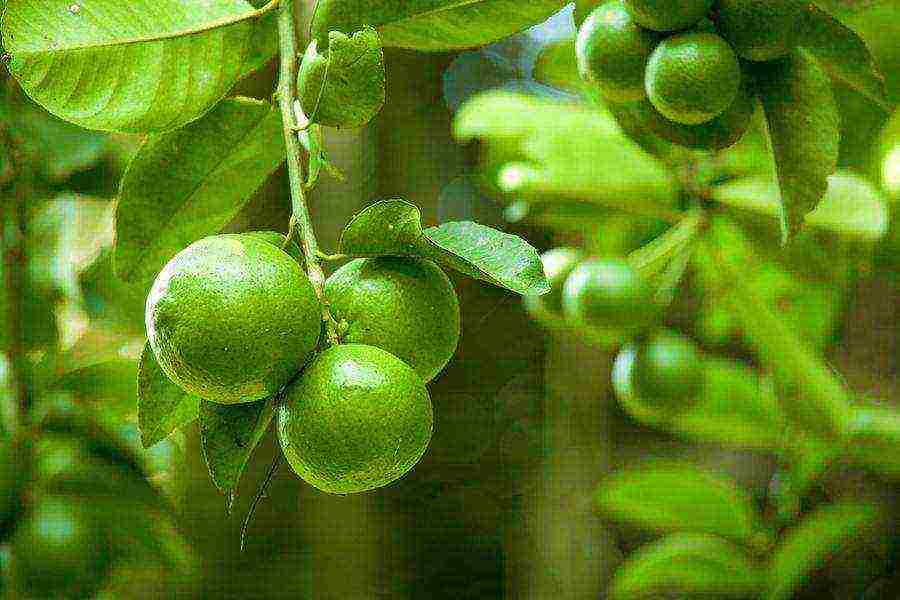
Even when mature, homemade lime has a green skin.
In indoor conditions, citrus does not grow above 1.5–2 m, but even if this height does not suit you, you can cut it. From pruning, the crown of the lime becomes even thicker and more flower buds are born on the branches.
Citrus characteristics:
- deciduous tropical plant;
- blooms and bears fruit all year round;
- flowers are white, small, up to 2 cm in diameter;
- fruits are green, juicy, with sour pulp.
The tree propagates by seeds, layering and cuttings. The most affordable way is to grow a tree from the seeds of a fruit purchased from a store.
Growing at home
To grow citrus at home, you need to understand its requirements as a tropical crop. Wood loves warmth, light and moisture. For it to bear fruit, you need a light, nutritious soil with a loamy component that retains moisture.
Initially, remove the citrus seeds from the fruit and place in moist soil, covered with glass on top. Planting period is March or April. After 2-3 weeks, a sprout will appear that needs light. Place it on the sill of a south window, but shade it at noon to prevent young leaves from getting burned.
Transplant the lime for the first time after 12 months using the transhipment method.
This means that the plant, together with the clod of earth, move into a new pot, the volume of which is 2–4 liters larger than the previous one. An adult plant will need a pots with a volume of 20 liters. If the tree branches weakly during growth, prune the vertical shoots in the spring, leaving 4–5 buds on each. Such a measure stimulates the plant to form new shoots and lay flower buds.
Lime begins to bear fruit after 3 years. Fruits reach 3–5 cm in diameter with 1–4 seeds inside. The tree can contain both flowers and ripe fruits at the same time. Use them fresh. Add to tea, compotes, desserts. The aromatic zest is used in the preparation of meat dishes and pastries. It is both an ornamental houseplant and a healthy citrus tree.
See also: growing lychee
Due to the fact that lime belongs to the citrus family, its cultivation and care will be no different from growing an orange or lemon. But, despite this, lime still has its own "whims". To begin with, it will tell you about the cultivation of citrus fruits at home.
Citrus fruits can be grown in two ways: from the seed or from the cuttings. Growing a tree from a stone will be a lot of trouble, but you will get full pleasure from watching the growth. When buying an already grafted plant or when rooting a cuttings it will be much easier, however…. In general, it's up to you to choose!
Growing citrus from a seed, as mentioned above, is a troublesome task, however, a healthy fruit-bearing plant will be the reward for patience and many years of work.
First, the citrus seed is washed, then dried for several hours and only then sown in a pot with a thick layer of drainage and soil from a mixture of river sand and garden soil.It should be noted that the pot must be deep enough - at least two liters, since young trees cannot be transplanted, otherwise they will die.
Next, the pot is placed in a plastic bag, inflated and tied. It turns out a mini-greenhouse. It must be opened periodically to water and feed the land. By the way, it will be necessary to build artificial lighting, tk. citrus fruits are very fond of warmth and their main growing environment is the tropics.
The first shoots will appear in a couple of months. Of these, the strongest should be left, the rest should be cut off. This strong emergence requires more careful and close maintenance.
The pot should be placed in fresh air, but without drafts; it is necessary to periodically spray, water with settled water; observe the "winter" regime (watering and feeding are less frequent); you also need to regularly pinch young shoots.
After a few years of painstaking work, the tree will bloom and begin to bear fruit.
Grown citrus fruits require slightly different care than seeds and seedlings.
First of all, you need to form a neat crown and carry out "health-improving" procedures - cut the tree. Pruning, by the way, is directly related to the process of fertilizing the plant. The better the tree is fertilized, the less often you need to prune it. In addition to mineral dressings, experienced gardeners recommend ... beer as fertilizer. Yes, you heard right: beer! Moreover, it is good to spray young citrus fruits with beer. From this, their leaves become brighter and more shiny. Leftovers of tea or coffee are also suitable for fertilization.
Unvaccinated citrus fruits begin to bear fruit in different ways, in particular, limes bear fruit after 3-4 years. Plants obtained vegetatively or grafted begin to bear fruit much earlier.
Lime certainly has its own characteristics. Let's consider them.
For the successful germination of lime from the stone, it needs a temperature of at least 25 degrees. When pruning a lime tree, a neat crown of 5-10 branches and a plump stem are formed. Lime seedlings are very large with thick roots. They remain viable for 2-3 weeks.
Among all plants of the genus Citrus, indoor lime has become very popular. Anyone can grow a lime at home with proper care.
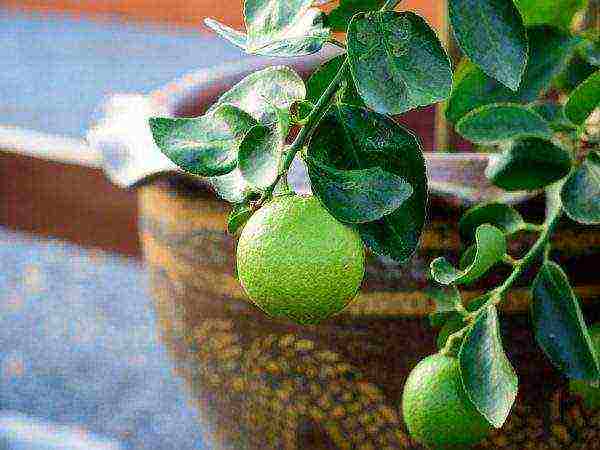
Growing lime at home
Plant characteristic
The birthplace of the plant is Southeast Asia (Malacca Peninsula). In its natural environment, this is a tall tree, reaching 1.5-4 m in height. The shoots contain small thorns. The leaves are long - up to 6 cm, up to 4 cm wide, dark green or emerald green.
The flower is white, formed in the axils of the leaves. The fruit is small in size - 5-6 cm in diameter. The fruit tastes sour or sweet, depending on the variety. The pulp is green, juicy.
Description of the plant:
- height no more than 2 m;
- the crown is spreading, contains many shoots, densely leafy;
- branches are covered with thorns 1-2 cm long;
- green fruits with tasty and juicy pulp.
The fruits of the plant are widely used in cooking for the preparation of various dishes - salads, desserts, drinks. This fruit tastes much sour than tangerine and lemon. Low calorie content (16 kcal per 100 g of product) allows you to include this fruit in the diet for those who want to lose weight. Of all the varieties, the Tahitian lime is the most popular. This lime variety is used in the preparation of the well-known mojito drink.
Growing features
You can grow a lime tree at home in two ways:
- seeds;
- cuttings.
Cuttings
To plant a lime tree, you need to cut off a 10-15 cm long shoot from the top of the tree. Such a shoot should have at least 5 healthy vegetative buds. All leaves on the handle are removed, leaving only 3 of the strongest and largest.
The cut is made at an angle of 45 ° using a sharp sterile instrument - a knife or secateurs. The cut cutting is treated with a root formation stimulant - Kornevin or Heteroauxin. Then the shoot is planted in wet sand.
For germination of indoor lime, special conditions are required - high humidity and temperature. Therefore, the plant is placed in a well-lit place where there is no direct sunlight and covered with a half of a plastic bottle. The escape is regularly ventilated and sprayed.
If everything is done correctly, in a month the indoor tree will take root. After that, he is gradually accustomed to room conditions, removing the shelter daily. Plants are transplanted into separate pots with a diameter of about 6-7 cm. Lime is planted in pots made of ceramic or clay material. In such a container, the root system of the plant is less susceptible to decay and will fully develop. The resulting hybrid begins to bloom and bear fruit as early as 3 years after planting.
Seed cultivation

Provide the plant with optimal conditions
When growing a lime at home, you need a seed from a quality fruit. Choose ripe fruit without mechanical damage and rot. The seeds are washed, then dried for 2 hours. For planting lime seeds, you must use a special substrate made of universal soil and coarse sand in a 1: 1 ratio. A layer of expanded clay (1.5 cm) is placed on the bottom of the pot, then the nutrient mixture is poured.
Seeds should be germinated in greenhouse conditions. In the process of germination, they are periodically ventilated and irrigated with warm water from a spray bottle. The success of growing a lime tree in this way will depend on a stable temperature regime in the greenhouse - 25-26 °.
Germination will take 2 to 4 months. Several sprouts are obtained from one seed.
They choose strong sprouts, on which 2-3 leaves have formed. The plantings are gradually accustomed to room air, then the seedlings are picked into separate containers with a diameter of no more than 6 cm. The composition of the soil is the same as when planting cuttings.
The first fruiting from seeds will begin at 4-5 years of age. The advantage of such cultivation is that the new plant retains all the varietal characteristics of the parent specimen.
Care rules
Maintaining a lime at home is not much different from growing a pomelo, orange, or other citrus plants.
Illumination
It is a sun-loving plant that prefers bright, diffused light. The best location is a window sill on the east or west side. The southern windowsill will require shading from the sun, especially at noon. Provide artificial supplementary lighting in the northern side.
A lime tree needs 12 hours of daylight.
Temperature
Depending on the season, homemade lime needs a different temperature of content. During the spring-summer period, this indicator is 30-35 °, in the autumn-winter period - 20-25 °. With this temperature regime, the plant will fully develop, bloom profusely and bear fruit.
Humidity
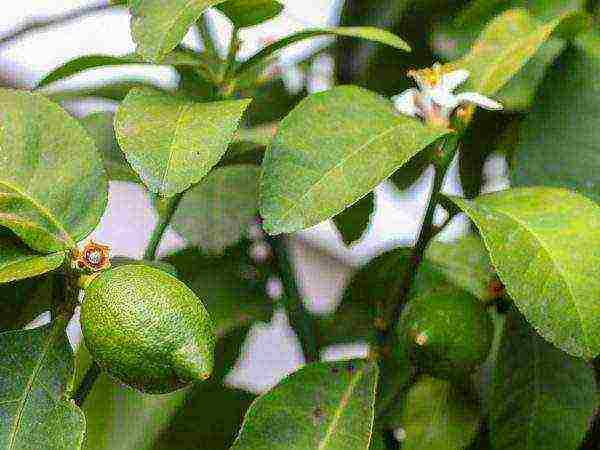
High humidity is important for wood
This plant needs high humidity throughout the year:
- daily irrigation of the crown from a spray bottle;
- shower with warm water - at least 2 times a month;
- placing the plant on a pallet with moistened sphagnum moss or expanded clay;
- placement of containers with water in the room.
Watering
Moderate watering is required when the topsoil dries out. In winter, watering is reduced - up to 3 times a month. Use water at room temperature.
Fertilizer
Growing lime in a pot requires regular fertilizing. A balanced diet will provide the plant with health and high-quality fruiting.
Twice a week, the plant is fed with a special complex fertilizer for citrus fruits.You can also use mineral and organic feed alternately. Mullein solution is used as organic matter. In winter, if the plant is kept in conditions of low temperature, no top dressing is applied. When kept warm in autumn and winter, lime is fed twice a week. The soil is spilled with a liquid solution until it begins to flow through the drainage holes. Top dressing is applied the next day after watering, which eliminates the risk of burning the root system.
Phosphorus-potassium preparations are used as mineral fertilizers. They stimulate the growth and development of the tree, as well as its flowering and fruiting.
Some growers use an unusual top dressing for this plant - fish ear. 200 g of fresh fish waste is poured with water, boiled for 5-7 minutes. Then it is diluted with boiled water in a ratio of 1: 2. Cool and filter through cheesecloth. Apply liquid fertilizer once a month after the plant reaches 1 m in height.
Pruning
Growing involves an annual haircut. Crown formation begins immediately after planting. Its apical shoot is cut off to stimulate the development of lateral branches.
The next year, all shoots are trimmed by 1/3 of the length. Shearing of all damaged, broken off branches is carried out.
Features of the formation of the crown in subsequent years consist in carrying out a sanitary haircut, removing branches that thicken the crown and growing at the wrong angle.
Transfer
They survive the plant in a new pot annually in late winter - early spring. Mature trees are transplanted less often - if the roots begin to grow through the drainage holes. For them, the surface layer of the earth is being replaced.
A commercial citrus mixture is suitable for transplanting, which has good moisture and air permeability. You can also plant in a mixture of turf, leaf, humus soil and sand, mixed in equal amounts. To eliminate the risk of injury to the roots, the transplant is carried out by transferring the earthen lump into a container 2-3 cm larger.
Diseases and pests 
Examine the plant for signs of disease
Most often this tree is affected by a spider mite, scabbard and mealybug.
Signs:
- the leaves are deformed, turn yellow and fall off;
- gray or black bloom appears on the upper side of the leaf plate;
- sticky coating on foliage and shoots;
- the appearance of microscopic bugs of red or red color;
- lumps in the form of a foam on the underside of the leaves or in the area of internodes;
- the appearance of a cobweb on the leaves;
- lime stops growing, does not bloom and sheds leaves en masse.
To destroy pests, the crown of plants is sprayed with soapy water. If such processing is ineffective, chemical preparations are used - Actellik or Aktaru.
Of the diseases, lime is most often annoyed by homoz. Small cracks on the shoots, from which a sticky liquid flows, are the main symptom of this disease. Such a plant dries up quickly and dies. The reasons for the development are too deep planting, frequent overflows and watering with cold water. The affected parts of the plant are treated with a solution of copper sulfate 3%. Then the barrel is lubricated with copper sulfate paste or lime paste.
Indoor varieties
Among all varieties, the following varieties of lime are most popular with flower growers:
- Palestinian;
- Mexican;
- lime tahiti;
- kaffir or kaffir;
- calamansi (musky)
- rangipur;
- limequat (limonella);
- lime kumquat;
- citrofortunella;
- orange (limetta).
Summer residents 16 11 16 2nd part Lemons, limes, tangerines, harvest on the windowsill
Lime: its scent relieves stress and relieves laziness
Conditions for growing citrus fruits (lemon, tangerine, orange, lime, kin-kan, pomelo) # Citrus
Conclusion
It is not difficult to care for this plant.If you follow all the above rules of maintenance, you will be able to grow a beautiful, flowering lime tree.

Reviews and comments
Lime Is an evergreen tree with an erect stem, branched and lignified.
Its height can reach 1.5 meters and more. The bark of the tree is brownish in color and outwardly rather thin.
The leaves are usually medium-sized, bright green in color, with a shiny surface and a pleasant scent. Some species may have thorny leaves.
The flowering of the tree usually occurs in the spring, however, the other period is also no exception.
This is an unusual plant, as it can simultaneously have flowers, and buds, and fruits. Flowers in growth reach a small amount of white, which can be located either singly or collected in a brush.
Fruit formation is very slow and reaches the period from 7 to 8 months from the date of flowering.
Growing lime
Location and lighting
Good lighting is required to grow limes. For full growth, a sunny room is suitable, but in the summer it is imperative to limit direct sunlight on the leaves and it is necessary to create a shade so that the plant does not get burned.
The most suitable place for growth would be east or west windowsills.
Lime needs 12 hour daylight hours, therefore, with the onset of autumn or winter, it is better to additionally install fluorescent lamps.
Moving a tree from one place to another is constantly undesirable, as it may stop growing and bearing fruit.
Temperature
During the budding period of lime, the air temperature is suitable 14 - 18 C °, if the temperature is higher, then the ovaries and buds may crumble.
With the onset of spring, when the air warms up to + 12 C °, you can not take it out into the open air for a long time, but you need to know that it does not tolerate sudden temperature changes.
Lime tolerates the cold season well at temperatures no higher 14 - 16 C ° and a certain air humidity.
It is advisable to ventilate the room every day. It is better not to put the tree near open vents in order to avoid drafts.
Watering and humidity
Lime loves abundant watering, especially in the spring and summer, but care must be taken that the plant is not flooded.
In winter, watering is necessary only when the top layer of the earth is completely dry, but it must not be allowed to dry out, otherwise the leaves will turn yellow and fall off.
Waterlogging can lead to bad consequences, namely root rot and, as a result, the death of the trunk.
You need to water with water at room temperature. In spring, watering is best done in the morning, and in summer and autumn in the evening.
Lime does not like air that is too dry, so with the onset of heat, you need to spray it 2 times a day with warm water.
Fertilizer
From March to October, the plant is in the stage of active growth and feeding is necessary during this period.
It is carried out every two weeks with a solution of complex fertilizers, in combination with mineral or organic additives.
In winter, when the plant is in a cold room, there is no need to fertilize the soil. If the room is slightly cool, then fertilization can be carried out. 1 time per month in moderation so that the lime does not suffer from overfeeding.
Transplant and reproduction
To plant a lime, you need a seedling, a clay pot and special soil. The best time to plant is late winter or spring.
In this case, the soil should be breathable, loose and contain humus, including sod and leafy soil with coarse sand.
At the bottom of the pot, it is customary to lay the drainage layer 2 - 3 cm from small stones, foam or other suitable material.
On top of the drainage is laid 1 cm dry manure and then potting soil. The root of the seedling should not be deepened much, it should be near the top layer of the pot.
After planting, immediately pour warm water and create a small greenhouse. If propagation is carried out by seeds, then the first seedlings appear approximately after 30 or 40 days, and the first harvest can only be expected in 6 - 10 years old, in case of compliance with all technological conditions of cultivation.
Plants grown indoors are very vulnerable and leaves may fall off when transplanting seedlings, so care should be as correct as possible.
Pests and diseases, the fight against them
Among the diseases that affect home lime, the most common and dangerous are soot fungus and gommosis.
With gommosis, the bottom of the trunk is covered with cracks, from which a sticky liquid is released. As a result, the crust dies off.
The causes of this disease can be deep planting, waterlogging or watering with cold water. The fight against this disease is to protect the disinfection 3m a solution of copper sulfate and smearing with a paste of lime or the same sulfate.
The sooty fungus appears as a dark coating and can be easily removed with a wet cloth or brush. Pests include shield, aphids, spider mite, and mealybug.
Share with your friends on social networks
